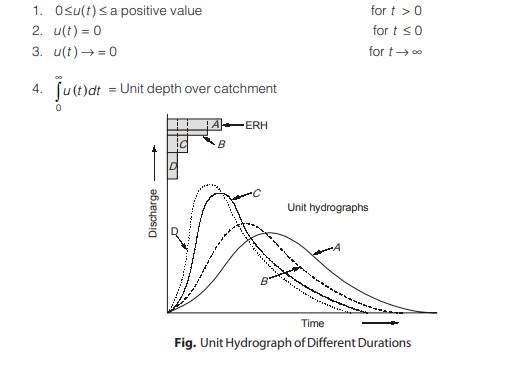Instantaneous Unit Hydrograph
A number of unit hydrographs can be drawn for a catchment corresponding to different durations. The shape of unit hydrographs depends on duration of D. Figure below shows a typical variation of shape of unit hydrographs for different values of D. As the value of D will decrease, intensity of rainfall excess being equal to 1D increases and unit hydrograph can also be drawn for a duration of rainfall approximately equal to zero. Thus, limiting case of a unit hydrograph of zero duration is known as instantaneous unit hydrograph (IUH). Thus, of IUH is a fictious unit hydrograph which represents surface runoff from catchment due to an instantaneous precipitation of rainfall excess volume of 1 cm. Let, ordinate of IUH is denoted by u(t ). Then, some of the properties of IUH can be listed as follows:


NOTE:
- It occurs when D->0 is used for IUH, it is also known as Time-area histogram method.
- It is assumed that the rainfall excess first undergoes pure translation and then attenuation.
OTHER TYPES OF HYDROGRAPH
A plot of the discharge in a stream plotted against time chronologically is called a hydrograph. Depending upon the unit of time involved, we have
- Annual Hydrograph: It shows variation of daily, weekly or mean flow of any number of successive days over a year.
- Monthly Hydrograph: It shows the variation of daily mean flow over a month.
- Seasonal Hydrograph: It shows the variation of the discharge in a particular season such as the monsoon season or dry season.
- Flood hydrograph or hydrographs due to storm: It shows stream flow due to a storm over a catchment hydrograph 1, 2 and 3 as above are called long term hydrograph and used for long term studies like
- Calculating the surface water potential of stream
- Reservoir studies and
- Drought studies
Flood hydrograph on the other hand is used to study the flooding characteristics of a stream. It is a short term study.
<< Previous | Next >>
Must Read: What is Hydrology in Civil Engineering?

